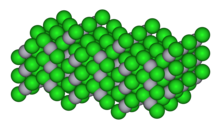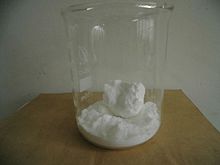Mercury(II) chloride
Other significant applications of mercuric chloride include its use as a depolarizer in batteries and as a reagent in organic synthesis and analytical chemistry (see below).[5] Upon treatment with an aqueous solution of mercuric chloride, aluminium strips quickly become covered by a thin layer of the amalgam.[6] Around 900, the authors of the Arabic writings attributed to Jabir ibn Hayyan (Latin: Geber) and the Persian physician and alchemist Abu Bakr al-Razi (Latin: Rhazes) were experimenting with sal ammoniac (ammonium chloride), which when it was distilled together with vitriol (hydrated sulfates of various metals) produced hydrogen chloride.Thirteenth-century Latin alchemists, for whom the De aluminibus et salibus was one of the main reference works, were fascinated by the chlorinating properties of mercury(II) chloride, and they eventually discovered that when the metals are eliminated from the process of heating vitriols, alums, and salts, strong mineral acids can directly be distilled.[14] For the preservation of anthropological and biological specimens during the late 19th and early 20th centuries, objects were dipped in or were painted with a "mercuric solution".[17] The process was generally abandoned because mercuric chloride was water-soluble and not effective for the long term, as well as being highly poisonous.[18] Mercuric chloride was a common over-the-counter disinfectant in the early twentieth century, recommended for everything from fighting measles germs[19] to protecting fur coats[20] and exterminating red ants.[21] A New York physician, Carlin Philips, wrote in 1913 that "it is one of our most popular and effective household antiseptics", but so corrosive and poisonous that it should only be available by prescription.Common side effects of acute mercuric chloride poisoning include burning sensations in the mouth and throat, stomach pain, abdominal discomfort, lethargy, vomiting of blood, corrosive bronchitis, severe irritation to the gastrointestinal tract, and kidney failure.Chronic exposure can lead to symptoms more common with mercury poisoning, such as insomnia, delayed reflexes, excessive salivation, bleeding gums, fatigue, tremors, and dental problems.



IUPAC namesCAS NumberChemSpiderECHA InfoCardEC NumberPubChemRTECS numberUN numberCompTox DashboardSMILESChemical formulaMolar massDensityMelting pointBoiling pointSolubility in waterSolubilityalcoholacetoneethyl acetatebenzenepyridineAcidityMagnetic susceptibilityRefractive indexCrystal structureCoordination geometryMolecular shapeStd molarentropyStd enthalpy offormationATC codeD08AK03Occupational safety and healthGHS labellingPictogramsHazard statementsPrecautionary statementsNFPA 704Flash pointSafety data sheetanionsMercury(II) fluorideMercury(II) bromideMercury(II) iodidecationsZinc chlorideCadmium chlorideMercury(I) chloridestandard statechemical compoundmercurychlorineformulareagentsyphilismercury toxicityhydrochloric acidnitratemercury(II) sulfatesodium chloridesublimationsublimeligandscatalystacetylenevinyl chloridepolyvinyl chloride1,2-dichloroethanedepolarizerorganic synthesisanalytical chemistryamalgamaluminiumHalocarbonsBarbier reactionnucleophilicreducing agentdithianeumpolunggas chromatographyJabir ibn HayyanAbu Bakr al-Razisal ammoniacvitriolsulfateshydrogen chloridechlorideArabic alchemicalHermes Trismegistusfalsely attributeHebrewinto LatinGerard of Cremonaalchemistsmineral acidscollodion processcopper sulfatecreosoteArab physicians in the Middle AgesantibioticsEnglishfolk songThe Unfortunate RakeThomas OverburyRobert CarrFrancesAlexandre DumasAntoine François Desrueslithium citrateLon Chaneysilent filmOlive ThomasJack PickfordMadge OberholtzerKu Klux KlanD.C. Stephensonstaph infectionHoracio QuirogaRuth L. Truffantbichloride of mercuryMercury poisoningacute kidney failureblood–brain barrierChisholm, HughEncyclopædia BritannicaBibcode